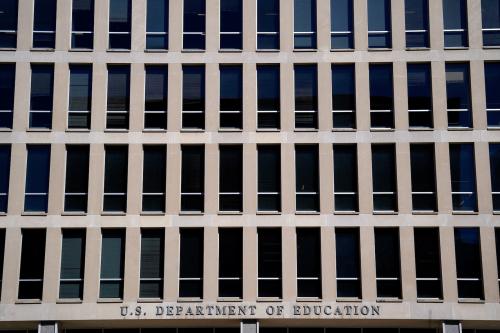The debate over student loans is a test of whether progressives can distinguish what we want from what we can afford, given political reality. So far, congressional Democrats are failing that test.
At the end of this month, interest rates on subsidized Stafford student loans will rise from 3.4 percent to 6.8 percent. It would have happened last year, but, facing an election, the parties agreed to extend the lower rate for a year. That was paid for by a mixture of hikes in pension insurance premiums and cuts in student aid.
Senate Democrats just tried to run a similar play, with a two-year, $8 billion extension, paid for by eliminating objectionable tax breaks. As the night follows the day, not one Republican voted for it.
Republicans’ proposal, which failed by a mirror-image vote, would link student interest rates to U.S. Treasury bill interest rates. This means that rates would stay low now, but rise again when interest rates increase. Republicans would dedicate the modest savings from using that approach to cutting the deficit. President Barack Obama’s proposal (on which I worked) also links to T-bills, but provides a better deal for lower-income borrowers and uses savings to fund investments.
The key question now is whether Democrats should continue to insist on extending the 3.4 percent rate, which as a practical matter will require offsetting spending cuts that Republicans can live with. Democrats seem inclined to go in this direction; party leaders are said to be looking at a one-year rather than a two-year fix.
That is the wrong answer. Extending the 3.4 percent rate is not a compelling policy goal, and Congress should preserve precious offsets for better purposes, beginning with Pell Grants.
In principle, there are two reasons to worry about the high interest rates on student loans. The first is that high rates might deter people from entering or finishing college. As others have argued, however, there isn’t much basis to believe this happens. When you apply to college, you don’t even know what kind of financial aid package you are going to get. You only learn later, after you complete your financial aid forms. Cost matters to the decision to attend or stay, but given everything we know from behavioral economics (and life) about human short-sightedness, what matters most is the total amount you need to pay while you’re in school, followed by the total amount you need to borrow.
Consistent with that view, research shows that increasing the amount of grant aid, and hence lowering the amount that needs to be spent or borrowed, really does affect college attendance. This is why the Pell Grant program is so important. But there is no evidence that students are basing college attendance and completion decisions on fine calculations about monthly payments when they graduate. And that is doubly true when the amount at stake is so modest: in the worst case, less than $40 per month.
The other reason to worry is that students already carry enormous debt burdens after they leave school, and high interest rates make those burdens worse. But here, the government is already providing a decent solution, allowing individuals to repay their loans as a fixed share of their income. For new borrowers, that share is capped at 10 percent of income above 150 percent of the poverty line, with repayment limited to 20 years. In some other countries, like Australia, this approach to loan repayment predominates, and it works. Here, students are defaulted into fixed-sum repayment plans, and few choose to switch.
One smart way to reduce loan burdens is to encourage the use of income-based repayment, perhaps by changing the default rule. And the truth is that the income-based repayment program itself should be reformed so that it no longer encourages graduate programs (especially law schools) to charge hefty fees and then leave taxpayers holding the bag. The 20-year repayment period also arguably provides more support than needed for high-income earners.
All of this said, the income-based program still targets struggling borrowers better than subsidized interest rates. By definition, income-based repayment benefits go to students based on their incomes after they graduate, when they actually need to repay their loans. By contrast, the interest subsidy now at issue is provided to students based on their family’s incomes before college. That isn’t when anybody actually repays their loans. A poor kid who becomes a hedge fund manager still gets the benefit, while a kid from a well-to-do family who chooses public service and hits hard times does not. That doesn’t make sense.
Even in the long-ago era of budget surpluses, the smart answer to rising student debt would never have been raising student subsidies. College costs have risen far faster than inflation, by some measures faster than health costs. Barely half of students finish their degrees within six years, and nearly one in five schools has a negative return. The key for higher education is to increase its productivity so that more students complete an education that costs less, is worth more, or both. That’s easier said than done, but pressure for better results is now coming from online providers. Obama also wants pressure to come from an aid allocation process that links schools’ aid to students’ outcomes. There are probably other good ideas to incentivize greater productivity. Unlike simply lifting student aid subsidies, these approaches can reduce debt burdens without raising taxpayer burdens.
Senator Elizabeth Warren, who is advocating cutting student interest rates even lower than the rest of the party based on a flawed analogy with loans to banks, says “the federal government is making a profit from our students.” But the federal government is not a profit-making business. The money the Treasury gets from students goes to pay its (our) bills. With interest rates tied to Treasury bills as in both Obama’s and Republicans’ plans, students are still getting a good deal on federal student loans. They offer lower rates and better terms than most banks’ loans to students, who typically lack collateral or work history. Keeping interest rates lower than they need to be inevitably shortchanges other priorities.
Last year, Congress paid for the one-year interest rate extension in part by reducing the period for which a student is eligible for a subsidized loan, from six years to four years for bachelor’s degree candidates. That was a good idea, since cutting off the subsidy sooner could encourage students to finish school faster. But Obama originally proposed to use the $1.2 billion in savings to forestall coming cuts in Pell Grants due to funding shortfalls in that program, and Pell Grants do far more than interest subsidies to help students in need attend and finish college.
Obama’s budget this year has $18 billion in smart student-aid savings that would be dedicated to protecting Pell Grants. Unlike last year, those savings should go where they are supposed to go. (And unlike in the current Republican proposals, any savings from loan changes should go into Pell Grants or other priorities.) If Democrats continue running last year’s play, they will end up with last year’s outcome, siphoning off savings that should be used for more pressing needs.
The Brookings Institution is committed to quality, independence, and impact.
We are supported by a diverse array of funders. In line with our values and policies, each Brookings publication represents the sole views of its author(s).



Commentary
Op-edExtending Lower Student-Loan Interest Rates Is Not the Answer
June 11, 2013